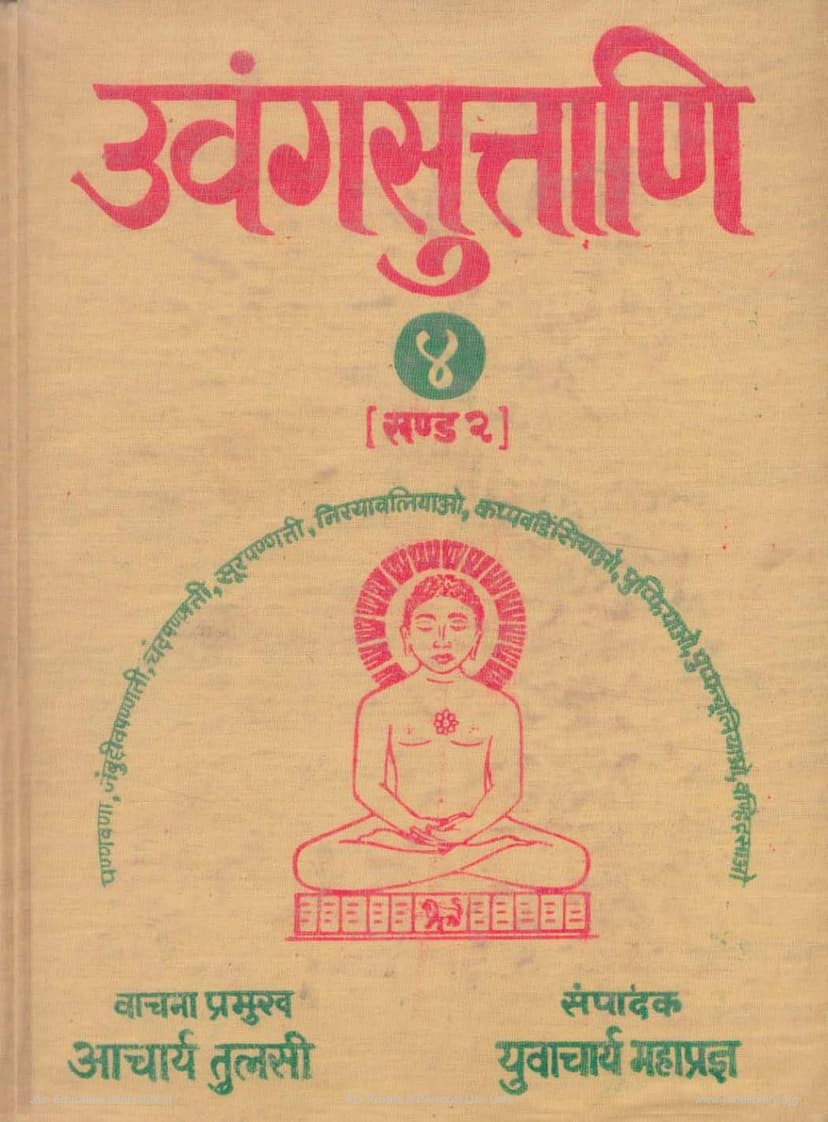Agam 21 Upang 10 Pushpika Sutra Puffiyao Terapanth
Added to library: September 1, 2025

Summary
This Jain text, titled "Agam 21 Upang 10 Pushpika Sutra Puffiyao Terapanth," is the second part of Volume IV of the "Uvanga Suttani" (Angavijja) series. Published by Jain Vishva Bharati and edited under the auspices of Acharya Tulsi and Yuvacharya Mahapragjna, it was released in Vikram Samvat 2045 (1989 AD) during the Maryada Mahotsava.
Key Features and Contents:
-
Nine Upangas: This volume contains the original text, critically edited with variant readings, of nine Upangas of the Jain Agamas. These are:
- Paṇṇavaṇā (Prajñāpanā)
- Jambuddīvapaṇṇatti (Jambudvipa Prajñapti)
- Candapaṇṇatti (Chandra Prajñapti)
- Sūrapannatti (Surya Prajñapti)
- Nirayāvaliyāo (Naraka Avatika)
- Kappavāḍisiyāo (Kalpa Vatamsika)
- Puṣphiyāo (Pushpika)
- Puṣphacūliyāo (Pushpa Chulika)
- Vaṇhidāsāo (Vahnidasha)
-
Comprehensive Series: The publication of this volume marks the completion of the "Agam-Sutta Granthamala" series, which has published a total of 32 Agamic texts. This critical edition, including original texts, variant readings, and word indexes, is considered a significant achievement in the history of Agama publications.
-
Editorial Vision: The project was initiated on Mahavira Jayanti in 1955 AD by Acharya Tulsi with the aim of researching and editing the Jain Agamas. The text correction phase began in 1957 AD and concluded in 1980 AD. The editorial approach emphasizes critical exposition, consultation of multiple manuscripts and commentaries, and the inclusion of detailed variant readings.
-
Content of Key Upangas (as detailed in the Introduction):
- Paṇṇavaṇā (Prajñāpanā): Focuses extensively on the two substances—sentient being (jiva) and insentient being (ajiva). It includes classifications of vegetable-bodied beings, descriptions of Aryas and Mlecchas, and discussions on Leśyā and Karma. Its author is believed to be Arya Shyam, flourishing in the 4th century of Vira Nirvana.
- Jambudvīvapaṇṇatti (Jambudvipa Prajñapti): Primarily deals with Jambudvipa, covering topics such as Lord Rishabha, Kulakaras, Bharata Chakravarti, the cycle of time (Kālacakra), and the solar system. It is noted for its vivid descriptions of Bharata Chakravarti's fourteen jewels and nine treasures, and its thrilling account of the sixth spoke of the descending cycle, which is compared to the horrors of atomic warfare. Its composition is attributed to an unknown elderly monk from the 4th-5th century of Vira Nirvana.
- Candraprajñapti and Sūraprajñapti: These are believed to be two separate Agamas, though their texts are largely identical in their available forms. The Candraprajñapti is considered largely unavailable, with the current available text potentially being the Surya Prajñapti. Their classification as Kalika and Utkalika in the Nandi Sutra is noted.
- Nirayāvaliyāo (Naraka Avatika): This Śrutaskandha's main theme is auspicious and inauspicious conduct, karma, and their consequences. The first section describes the battle between Chetaka and Konik, the second narrates the salvation of Shrenik's ten grandsons, and subsequent sections cover the practices of restraint, the disciples of Parshvanatha, and the princes of the Vrsni dynasty. Its author and time of composition are unknown.
-
Editorial Process and Contributions: The text underwent rigorous research and critical editing, with significant input from Muni Sudarshanji, Muni Hiralalji, Muni Srichandji 'Kamal', Muni Balchandji, Muni Madhukarji, and Sadhvi Jinaprabhaji and Sadhvi Chandanbalaji for word indexes. Proofreading involved Muni Sudarshanji, Muni Hiralalji, Muni Dulaharajji, and Samani Kusumpragya. Various institutions provided invaluable manuscript support.
-
Dedication: The volume is dedicated to the revered gurus, including Acharya Tulsi, Yuvacharya Mahapragna, and Kalugani, for their scholarly contributions and guidance.
-
Publisher's Note: Jain Vishva Bharati expresses its gratitude to all contributors and financial supporters, including the Mitra Parishad, Calcutta, for establishing the Jain Vishva Bharati Press. The work is presented as a significant step in making the 32 Agamas accessible to scholars and the public.
In essence, this book is a monumental scholarly effort to preserve and present a critical edition of crucial Upanga texts within the Jain Agamic canon, providing a valuable resource for scholars and followers of Jainism.